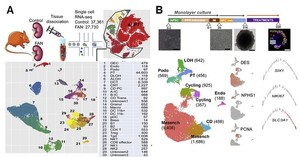International joint research with Gist-University of Pennsylvania-Barcelona University of Science and Technology
[베리타스 알파=유재명 기자] The team of Professor Ji-Hwan Park of the Gist Department of Life Sciences discovers key regulators that play an important role in the process of developing normal kidney development into chronic kidney disease through international joint research with the University of Pennsylvania, Spain, and the Barcelona University of Science and Technology. Presented.
The research team analyzed the kidney, one of the organs composed of the most complex cell types in our body through the latest single-cell analysis technology, at the level of individual cells, and identified important cell types in the development of chronic kidney disease, and regulated the differentiation and metabolism of these cells. We discovered estrogen-related receptors that play a central role in
Single cell analysis technology: It is a technology that can analyze the expression of all genes expressed in tens of thousands of individual cells in one experiment, and is recently evaluated as one of the most important next-generation technologies in the fields of biology and medical life.
Chronic kidney disease is a disease commonly associated with diabetic hypertension, and the number of patients worldwide is increasing rapidly to about 800 million. When it develops into end-stage kidney disease, there is no cure except for dialysis and kidney transplant, which causes great pain to patients and their families, and the socioeconomic cost of disease is high. Once chronic kidney disease begins to progress, there is still no cure to stop or recover, so the development of a new therapy is urgent.
Through single-cell analysis of human chronic kidney disease-induced animal model kidney organ analogues, the research team found that in chronic kidney disease, there are many incorrectly differentiated proximal tubular epithelial cells in the kidney, and that there is a problem in their lipid metabolism. Revealed. It was confirmed that the key regulator of proximal tubular epithelial cell differentiation and lipid metabolism is an estrogen-related receptor, and it can control chronic kidney disease by inhibiting or overexpressing this gene.
Professor Ji-Hwan Park said, “The research has the greatest significance in discovering key cell types and regulators of chronic kidney disease by incorporating the latest technologies such as single-cell analysis technology and kidney organ analogues.” “We have confirmed the possibility of developing a drug that is only specifically effective.”
This research, which Professor Ji-Hwan Park participated in, was carried out with support from the Korea Research Foundation’s New Researcher Support Project and the Basic Research Laboratory.
–
Copyright © Veritas Alpha Unauthorized reproduction and redistribution prohibited
– .


